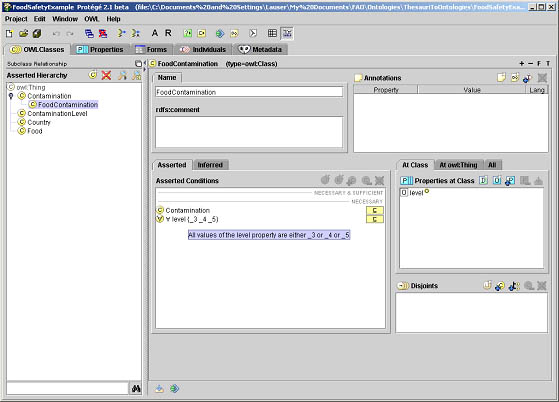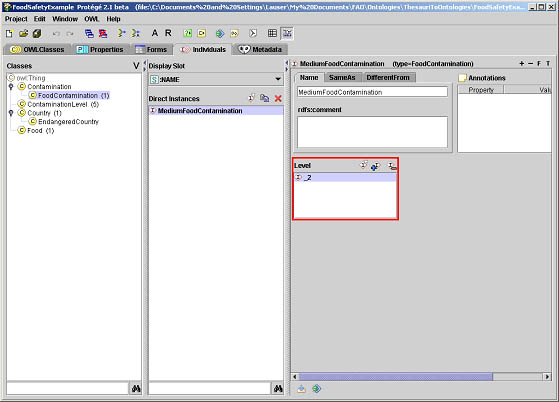OWL adds more vocabulary for describing concepts and properties. One of the most important features of OWL is overriding properties at the class level using restrictions. In our example before in RDFS we could not model that Food Contamination is a Contamination with levels >= 3. In OWL this is now possible simply by including a restriction on the class level of “Food Contamination”. For this purpose we first introduce a new class “Contamination Levels” and populate it with 5 instances {1,2,3,4,5} that define the different levels. On the class level of “Food Contamination” we now add a restriction stating that all values of the “level” property (which is already inherited from “Contamination”) must be one of the values {3,4,5}. Figure 5 shows the class “Food Contamination” with its restriction on the property “Level”. The example OWL ontology has been modelled in Protégé[5], an ontology editor which recently released an OWL plug in. The code of the sample ontology is attached in Appendix B.

Figure 5: Modelling class level restrictions in OWL using Protégé
In RDFS there is no mechanism that would prevent from creating an instance of “Food Contamination” with a level 2 or lower. In Protégé on the other hand, having added the OWL restriction on the class level, trying to create such an instance will raise an exception as shown in Figure 5.
These class level restrictions finally are a powerful instrument that can be used for inference, since reasoners can use such restrictions to infer knowledge and deduct links that are not modelled explicitly. Other useful restrictions in OWL include cardinality, i.e. to model that a property must have at least or at most x values.
Besides class level restrictions, the OWL web ontology language introduces several more additional features over RDFS, some of the most important are:
- Equality:
In OWL you can explicitly state that two entities are equal. This is especially helpful in the case of integrating or merging ontologies. In RDFS you could not state for example that the two instances ‘Burger’ and ‘Hamburger’ actually refer to the same physical entity. In OWL you can so this using the equivalence statement.- Versioning:
RDFS did not provide any ontology versioning and metadata information. This is extremely important especially with evolving ontologies. As ontology engineering and maintenance is an ever ongoing process, OWL introduced the feature of adding metadata and versioning information to keep track of ontology development over time.- Data Types
In RDFS no data types as we know from programming languages (String, Integer, Float, etc.) could be used for attributes of concepts. In order to close this gap, OWL introduces the use of such standard predefined data types.
OWL provides a few more features than the ones mentioned here and we do not want to go into the details of all of them within this overview. For a full list of OWL features, refer to the online OWL web ontology language guide[6].

Figure 5: Enforcement of class level restrictions in OWL
It becomes obvious in the above last example that such modelling paradigms in the case of OWL provide powerful opportunities for knowledge inference. In the example above, one could imagine to have a country food safety alert system that categorized a country into an alert status, if a certain number of food items are contaminated with a certain level. The creation of such tools has not been possible with the simple knowledge that can be extracted from a thesaurus, but becomes only possible exploring the powerful features, ontology modelling provides.
|
[5]
http://protege.stanford.edu. [6] http://www.w3.org/TR/owl-guide/. |